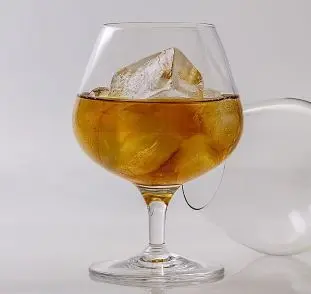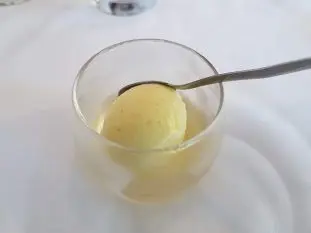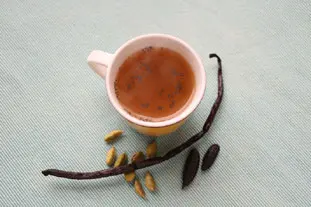The return of the "Norman hole"

You maybe know the "trou normand", this old gastronomic custom typically French which consists in taking a (small) glass of calvados, generally between the last course and the dessert?
It's something that seems a bit anachronistic nowadays, having a glass of an alcohol of more than 60° in the middle of a meal, often with wines, to supposedly "ease digestion", ouch!
It's something that seems a bit anachronistic nowadays, having a glass of an alcohol of more than 60° in the middle of a meal, often with wines, to supposedly "ease digestion", ouch!
12 K 4.8/5 (13 reviews)
Keywords for this post:MealCustomNormandyNormandCalvadosSorbetLast modified on: December 18th 2021
The return of the "Norman hole"
If the original practice is rather debatable (personally, I'm almost sure that I won't see the dessert, or else in a fog :-), the principle on the other hand is not stupid: In a rather rich meal, like a holiday meal, take a little break before the dessert, and why not, by tasting something different.
It is a little bit towards that that the usage has been adapted for several decades, we always practice the Norman hole, but it is rather with something fresh, like a sorbet, often alcoholic, we do not completely remake.
The great classic, always in the Norman spirit, is a small dish with an apple sorbet, without or with a dash of calvados poured over it just before serving, or its "colonel" version with lemon and vodka sorbet.
The freshness of the sorbet, welcome at the end of the meal, is typical of what great restaurants call the pre-dessert.
In the end, it is a certain contrast that is sought, we have just eaten the main course, often quite substantial, perhaps washed down with strong wines, our mouths are a little full, a touch of lightness, of freshness, would be welcome.
Someone who is a bit strict might tell you to stop fussing, and simply drink a glass of fresh water, that it would be enough, and he would probably be right, but it is a holiday meal, we want to get out of the ordinary.
But instead of limiting yourself to the two initial options, alcohol alone (classic but outdated) or sorbet/ice (more modern but overused), it is also possible to think outside the box and go for something more daring, here are some ideas for, perhaps, your upcoming holiday meals.
- You don't serve anything with it, no little cookies or sweets, that would be too much.
- We serve the guests, and we sit with them right away, it is also a moment of exchange, the preparation of the dessert can wait a little.
- Or something fresh like a small iced coffee, a fruit mousse, a very light cream, a red fruit chantilly, or even a small fresh fruit salad.
- More daring, it could be something hot: a sabayon, vanilla or with a hint of citrus, served in a tiny cup.
- Last hot/tidy idea: mulled apple juice (my favourite), or hot cider.
In all of this, you should find something that will pass the "trou normand" test with flying colors with your guests, and who knows, maybe even surprise them a bit.
In summary:The "trou normand" in its principle, a refreshing break in a meal, is a good idea that can be declined in many ways, not necessarily alcoholic.
It is a little bit towards that that the usage has been adapted for several decades, we always practice the Norman hole, but it is rather with something fresh, like a sorbet, often alcoholic, we do not completely remake.
The great classic, always in the Norman spirit, is a small dish with an apple sorbet, without or with a dash of calvados poured over it just before serving, or its "colonel" version with lemon and vodka sorbet.
The freshness of the sorbet, welcome at the end of the meal, is typical of what great restaurants call the pre-dessert.

In the end, it is a certain contrast that is sought, we have just eaten the main course, often quite substantial, perhaps washed down with strong wines, our mouths are a little full, a touch of lightness, of freshness, would be welcome.
Someone who is a bit strict might tell you to stop fussing, and simply drink a glass of fresh water, that it would be enough, and he would probably be right, but it is a holiday meal, we want to get out of the ordinary.
But instead of limiting yourself to the two initial options, alcohol alone (classic but outdated) or sorbet/ice (more modern but overused), it is also possible to think outside the box and go for something more daring, here are some ideas for, perhaps, your upcoming holiday meals.
A few rules that can't be ignored
- We stick to something small, a ramekin for example is too big, you need a very small glass, or a cup, or an espresso/ristretto cup.- You don't serve anything with it, no little cookies or sweets, that would be too much.
- We serve the guests, and we sit with them right away, it is also a moment of exchange, the preparation of the dessert can wait a little.
And some suggestions
-It can be something very cold, a fruit sorbet with a little acidity for example: apple already mentioned, citrus fruits (clementine for example) or red fruits.- Or something fresh like a small iced coffee, a fruit mousse, a very light cream, a red fruit chantilly, or even a small fresh fruit salad.
- More daring, it could be something hot: a sabayon, vanilla or with a hint of citrus, served in a tiny cup.
- Last hot/tidy idea: mulled apple juice (my favourite), or hot cider.

In all of this, you should find something that will pass the "trou normand" test with flying colors with your guests, and who knows, maybe even surprise them a bit.
In summary:The "trou normand" in its principle, a refreshing break in a meal, is a good idea that can be declined in many ways, not necessarily alcoholic.
Lasts posts
Cake moulds
When we make a cake, or a cake of the same rectangular shape, we usually take out our usual mould and tell ourselves that the recipe is anyway "for a cake", but is it really that simple?August 25th 20256545
Thinning out herbs
If you need to add a long-stemmed herb (tarragon, mint, verbena, thyme, etc.) to a recipe, you'll probably only need the leaves and not the stem, so you'll need to remove the leaves. Leaf removal means keeping only the beautiful leaves, and eliminating the ugly stems and leaves, but how do you do...August 8th 20251,1775
Add a bay leaf
Bay leaf: small in size, but big in flavor. You'll find it in hundreds of recipes, and it's often added to cooking meat, in a sauce or broth, usually accompanied by other herbs or products. It's a staple of Provençal, Mediterranean and Oriental cuisine, but not the only one. Usually, in a...July 31th 20251,2685
Parsley stems
Parsley, whether curly or flat, is a delicious ingredient in many recipes, where it is used both raw and cooked. When used raw, in a salad for example, where it always provides, alone or with other herbs, a remarkable freshness, only the leaves are kept. And when used cooked?July 28th 20251,354 13
A drizzle of olive oil
Often in a recipe, you have to "baste" vegetables, for example, before sending them to the oven. What the author means by this is that you need to put oil on top of the vegetables to cook them in the oven. Typically, we just quickly drizzle oil over the vegetables, hoping not to miss any, but...July 13th 20251,5485
Other pages you may also like
Thinning out herbs
If you need to add a long-stemmed herb (tarragon, mint, verbena, thyme, etc.) to a recipe, you'll probably only need the leaves and not the stem, so you'll need to remove the leaves. Leaf removal means keeping only the beautiful leaves, and eliminating the ugly stems and leaves, but how do you do...August 8th 20251,1775
Small, regular pieces
When we cook, bake or pastry, we often have to cut food into small pieces, often cubes, to incorporate them into a recipe or preparation. How do you get regular pieces fairly quickly?November 28th 20208,6954.5
In praise of Mont d'Or cheese
Do you know the Mont d'Or, this extraordinary cheese from the Haut-Doubs in France, with a unique taste and appearance, which can be eaten both raw and cooked? I'll tell you a few words about it, and with some tips on how to choose it and cook it. .November 27th 202110 K5
Maillard reactions
This subject cropped up recently in a discussion with my three charming nieces; do you know what Maillard reactions are? With a name like that, they could well be some principle in mechanics, but in fact the term applies to something much closer to all of us: it's what gives food more flavour...January 28th 201535 K4
In praise of the whetstone
Have you ever seen a butcher or a chef sharpen his knife before using it? Usually he uses a special tool, a long thin cylinder made of very hard metal. And in a smooth and elegant gesture, he very quickly passes the edge of the knife against the rifle, which makes a very characteristic noise,...June 5th 20219,2564.8
Post a comment or question
Follow this page
If you are interested in this page, you can "follow" it, by entering your email address here. You will then receive a notification immediately each time the page is modified or a new comment is added. Please note that you will need to confirm this following.
Note: We'll never share your e-mail address with anyone else.
Alternatively: you can subscribe to the mailing list of cooling-ez.com , you will receive a e-mail for each new recipe published on the site.








